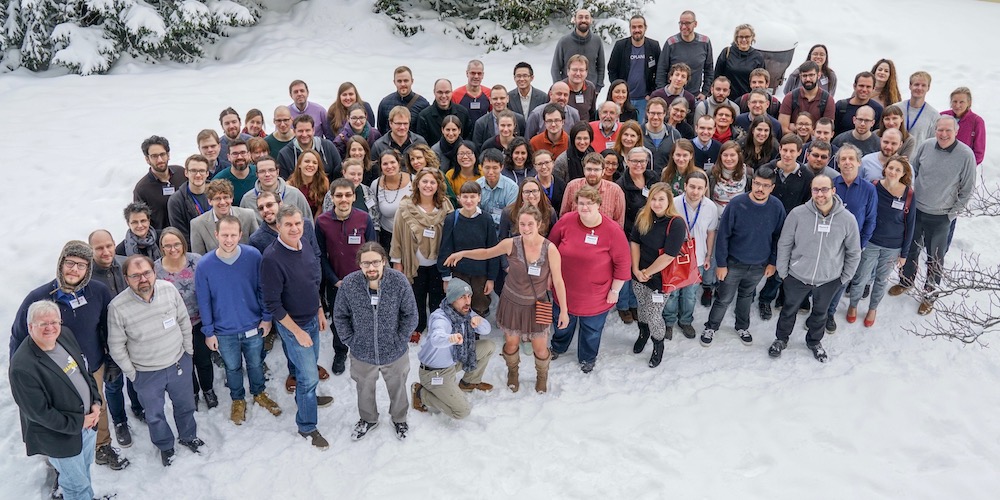A golden age for planetary scientists

The NCCR PlanetS is now in its second four-year-long phase. 122 members and associates gathered at the end of January 2019 to review what they have achieved and discuss new research projects.

PlanetS members and associates met in Beatenberg for their 5th General Assembly. (Photo Sylviane Blum)
Research initiatives such as PlanetS are temporary projects. The Swiss National Science Foundation SNSF funds National Centres of Competence in Research (NCCR) for periods of four years. Then, after a thorough review that includes international experts, it decides whether the program is continued and how much funding is allocated for a next phase – a procedure that puts the scientists under considerable pressure. No wonder PlanetS Director Willy Benz was delighted when he received the good news in mid-December 2019 that PlanetS is able to continue with even a slight bonus until 2022. “Obviously, the review panel of international experts and the SNSF were happy with us,” he summarized at the PlanetS General Assembly at the end of January in Beatenberg.
A big happening for the astronomers in 2018 was the special performance of ESPRESSO, the new high-resolution spectrograph developed by a consortium led by the Astronomical Observatory of the University of Geneva and installed at ESO’s Very Large Telescope VLT in Chile. For the first time the light of all four 8.2-metre Unit Telescopes was brought together to feed a single instrument – ESPRESSO. This made the VLT equivalent to a 16-metre telescope – the largest optical one in existence by far. To combine the light of all four telescopes was something ESO planed from the beginning of the construction of Paranal observatory for interferometric purpose, this is however the first time that the light was combined at the incoherent focus of a VLT instrument.
The construction of another new instrument was completed in 2018: CHEOPS, the CHaracterising ExOPlanet Satellite that will measure radii of known planets with high precision, is now waiting at Airbus in Madrid to be shipped to Europe’s spaceport at Kourou, French Guyana later this year. The first research satellite under joint Swiss-ESA leadership is due to be launched between 15 October and 14 November 2019. “The construction was finished within budget and we are ready for the first launch opportunity as a secondary passenger” said Willy Benz, Principal Investigator of the mission: “And the tests show that CHEOPS is well within specifications at least in the laboratory.” For the construction of the satellite no NCCR money was used but a platform within PlanetS provides the organization and funding for a high-visibility science exploitation of the mission. “At the next General Assembly, we will have the first data – if everything goes well,” Willy Benz said.
From meteorites to machine learning
To optimize synergies between different research groups and increase the flexibility of the organization the PlanetS board decided to start phase 2 with restructuring the research into three domains. “Early stages of planet formation” is the title of domain 1. Whereas one research group looks at observational data of planet forming disks around young stars, another one creates 3-D simulations with one of the world’s most powerful supercomputers at the CSCS in Lugano. In addition, teams in Zürich and Bern study so called chondrules, the major constituents of primitive meteorites and devise new experiments to investigate the streaming instability which is thought to bring small solids together thereby assembling the first planetary building blocks. “Our goal is to explore the first million years of planet formation,” explained Lucio Mayer of the University of Zürich who is the speaker of domain 1. Integrating the different approaches, the PlanetS researchers hope to get a better understanding of how at the very beginning particles up to meter size were built which is still a mystery.
Domain 2 deals with “Planetary systems architectures, formation and evolution”. “We are in a golden age now with new instruments on the ground and in space,” said Stéphane Udry, Co-Director of PlanetS. These large and precise tools allow studying the wide variety of planets and systems and make predictions about their inner structure depending on the environment during their formation and evolution. On a parallel branch theorists study similar topics using models and computer simulations. To process the vast amount of data the researchers develop advanced statistical techniques inspired by machine learning and big data science. But as important as these individual studies are, the link between theory, observations, and laboratory remains a focus within the framework of PlanetS.
“Atmospheres, surfaces, and interiors” are the topics of domain 3 (see article by Pierre). It also includes remote sensing of objects in the Solar System. At present, CaSSIS, the Colour and Stereo Surface Imaging System built at the University of Bern is orbiting and observing Mars aboard ESA’s ExoMars Trace Gas Orbiter (TGO). “The NCCR PlanetS was a massive help to the CaSSIS instrument,” said Prinicipal Investigator Nicolas Thomas: “We already have thousands of images in stereo and got a lot of publicity from ESA.”
Not all the projects in domain 3 are funded by PlanetS, some got grants from the European Research Council (ERC) or are financed by the SNSF via a special professorship. With the new structure, it is easier to include research groups that are externally funded which is important since the NCCR will end after 3 phases in 2026 at the latest. “We want to transfer PlanetS into a Swiss Institute of Planetary Sciences (SIPS) that will carry on the activities beyond the lifetime of the NCCR,” explained Willy Benz. Such a transition will not be an easy exercise, but all participating institutions (the Universities of Bern, Geneva, and Zürich and ETH Zürich) have agreed to meet and discuss how this can be achieved.
Image gallery

